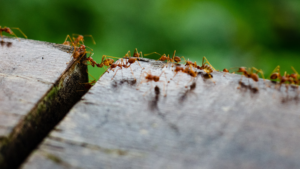
Fire Ant Infestations: Long-Term Solutions for Texas Homeowners
Fire ants are tiny but mighty pests that can cause big problems for Texas homeowners. These little bugs are not just annoying; they can also be dangerous. Fire ants build large mounds and have a painful sting that can cause serious allergic reactions in some people. Understanding how to manage and get rid of fire ants is crucial for keeping your yard safe and enjoyable.
Fire ants are known for their aggressive behavior and ability to adapt to different environments. They can quickly take over a yard, making it unsafe for kids, pets, and even adults. Once you have identified a fire ant problem, you need to act fast to control it before it spreads further. Unfortunately, many DIY methods offer only temporary relief and do little to address the root problem.
In this article, we’ll explore the challenges fire ants pose and the best long-term solutions for controlling them. You’ll learn why professional fire ant control is often the best choice for lasting results. By the end, you’ll have a clear understanding of how to keep your lawn fire ant-free for good.
What Are Fire Ants?
Fire ants are a type of stinging insect known for their aggressive behavior and painful bites. There are several species, but the Red Imported Fire Ant (RIFA) is the most common in Texas. These ants were accidentally brought to the United States from South America and have spread rapidly due to their adaptability. 
Fire ants are small, usually about 1/8 to 1/4 inch long, and reddish-brown in color. They live in large colonies that can contain hundreds of thousands of ants, including workers, soldiers, and a queen. These colonies build mound-like nests in open areas, which can be easy to spot in your yard.
Fire ants are omnivorous and will eat almost anything, from plants to small animals. Their colonies can be very aggressive when disturbed, making them a significant threat to both people and pets. Understanding what fire ants are helps in identifying and treating them more effectively.
How to Identify Fire Ants in Your Yard
Spotting fire ants in your yard can help you take action before they become a bigger problem. Here are some key signs to look for:

1. Mounds:
Fire ant colonies build large, dome-shaped mounds. These mounds are usually found in open, sunny areas and can reach up to 18 inches in height.
2. Ant Trails:
Fire ants often form visible trails as they move between their nest and food sources. These trails can help you locate their mounds.
3. Ant Appearance:
Fire ants are reddish-brown and range from 1/8 to 1/4 inch in length. They look different from other types of ants, which helps in identification.
4. Aggressive Behavior:
If you disturb their mound, fire ants will swarm out aggressively. This behavior is a clear indicator that you’re dealing with fire ants.
By recognizing these signs, you can quickly identify a fire ant infestation and take steps to control it. Early detection is crucial for effective treatment and prevention.
Why Are Fire Ants a Problem?
Fire ants pose several significant problems that make them more than just a nuisance. Understanding these issues can help you see why controlling them is so important:
1. Painful Stings:
Fire ants have a venomous sting that can cause intense pain, itching, and swelling. For people allergic to their venom, stings can lead to severe reactions requiring medical attention.
2. Damage to Property:
Fire ants can damage plants, lawns, and electrical equipment. They often chew through wires and can cause short circuits and other electrical problems.
3. Impact on Pets and Wildlife:
Fire ant stings can harm pets and wildlife. Small animals and birds can be killed by fire ants, disrupting the local ecosystem.
4. Rapid Spread:
Fire ants reproduce quickly and can spread rapidly, making them hard to control once they’ve established a colony in your yard. A single queen can lay thousands of eggs, leading to large colonies in a short amount of time.
Due to these problems, it’s essential to take fire ant infestations seriously and seek effective long-term solutions to control them.
Health Risks Posed by Fire Ant Stings
Fire ant stings are not just painful; they can also pose serious health risks. Here are some of the potential dangers:
1. Allergic Reactions:
Some people are allergic to fire ant venom. For these individuals, a sting can cause severe allergic reactions, including swelling, difficulty breathing, and anaphylaxis, which is life-threatening and requires immediate medical attention.
2. Infection:
Fire ant stings can break the skin, creating open wounds that can become infected if not treated properly. It’s important to clean and monitor stings to prevent secondary infections.
3. Multiple Stings:
Fire ants attack in large numbers. A person or animal can receive multiple stings in a short period. Large numbers of stings can lead to more severe reactions and increase the risk of complications.
4. Pain and Discomfort:
The pain and itching from fire ant stings can last for several days. For children, the elderly, and those with sensitive skin, this can be particularly challenging and uncomfortable.
Understanding the health risks posed by fire ant stings underscores the need for effective control and prevention strategies. Reducing the presence of fire ants in your yard can help keep you, your family, and your pets safe from these dangers.
Common Myths About Fire Ant Control
There are several myths surrounding fire ant control that can lead to ineffective management. Let’s debunk these common misconceptions:
1. Boiling Water Works:
– Myth: Pouring boiling water on a fire ant mound will kill them all.
– Reality: While boiling water may kill some ants, it rarely reaches deep enough to destroy the entire colony. This method is also dangerous and can harm surrounding plants.
2. Instant Results with Store-Bought Baits:
– Myth: Over-the-counter baits will solve your fire ant problem quickly.
– Reality: Many store-bought baits do not attract fire ants effectively or target only a small portion of the colony, offering temporary relief at best.
3. Fire Ants Won’t Return After Treatment:
– Myth: Once treated, fire ants will not come back.
– Reality: Fire ants can and often do return, especially if nearby colonies exist. Continuous monitoring and treatment are essential.
4. They Only Live in Rural Areas:
– Myth: Fire ants only infest rural or undeveloped areas.
– Reality: Fire ants can thrive in both urban and suburban settings, making vigilance important for all homeowners.
Dispelling these myths helps in adopting more effective and reliable methods of fire ant control.
DIY Fire Ant Control Methods
Many homeowners resort to DIY methods to control fire ants, hoping for a quick and inexpensive solution. Here are some common DIY approaches and their effectiveness:
1. Natural Remedies:
- Vinegar: This household item is often used, but it rarely affects the entire colony.
- Cinnamon: Sprinkling cinnamon can deter ants temporarily but won’t kill the colony.
2. Chemical Solutions:
Over-the-Counter Baits and Sprays: These can kill some ants but often fail to reach the queen and the deeper parts of the colony.
3. Mechanical Methods:
Digging Up Mounds: This method is labor-intensive and usually ineffective since you often leave behind parts of the colony.
4. Boiling Water:
Pouring boiling water on mounds can kill some ants but is dangerous and not fully effective in eliminating the colony.
While these DIY methods might provide short-term relief, they often miss the mark on long-term control. You’ll likely find that the ants come back, and sometimes in greater numbers than before.
Why DIY Solutions Often Fail
DIY fire ant control methods frequently fail for several reasons. Understanding why they don’t work can save you time and frustration.
1. Incomplete Eradication:
Many DIY methods only kill surface ants and leave the queen and deep nest untouched. This allows the colony to rebuild quickly.
2. Lack of Professional Expertise:
Without knowledge about the behavior and life cycle of fire ants, treatments are often improperly applied, leading to poor results.
3. Temporary Solutions:
Most DIY remedies offer only a temporary fix. They do not prevent new infestations or address underlying issues that attract fire ants to your yard.
4. Incorrect Application:
Misapplying baits or sprays can make the problem worse. Fire ants can spread and create multiple new colonies when disturbed.
Because of these shortcomings, homeowners usually find themselves battling fire ants repeatedly without gaining permanent control. Professional solutions provide more effective and enduring results.
Benefits of Professional Fire Ant Control
Opting for professional fire ant control offers numerous advantages over DIY approaches. Here’s why professional treatment is often the best choice:
1. Expertise and Knowledge:
Professionals know fire ant behavior, life cycles, and colony structures. This allows them to target treatments more effectively.
2. Advanced Products:
They have access to high-quality, specialized products not available to the general public. These products are designed to reach the entire colony, including the queen.
3. Comprehensive Approach:
Professionals use integrated pest management techniques, combining multiple strategies for long-term control and prevention.
4. Safety:
Professionals know how to apply treatments safely, minimizing risks to your family, pets, and the environment.
5. Monitoring and Follow-Up:
They offer ongoing monitoring and follow-up treatments to ensure the fire ants do not return, providing peace of mind.
Hiring professionals for fire ant control ensures that the problem is addressed thoroughly and effectively, saving time, effort, and frustration in the long run.
How Professionals Treat Fire Ant Infestations
Professionals use proven methods to tackle fire ant infestations effectively. Here’s what to expect from professional treatment:
- Comprehensive Inspection: The first step is a thorough inspection of your yard to locate all fire ant mounds and assess the severity of the infestation. Professionals are trained to identify signs of fire ant activity that you might miss.
- Targeted Baiting: Professionals often use bait that attracts fire ants. The ants take the bait back to their colony, which helps to kill the queen and the entire mound. This method is systematic and reduces the likelihood of ants relocating.
- Chemical Treatments: In addition to baiting, professionals may apply insecticides directly to the mounds and surrounding areas. These treatments are designed to provide quick control and are typically safe for your lawn when applied correctly.
- Monitoring and Follow-Up: Treating fire ants isn’t a one-time deal. Professionals will often schedule follow-up visits to monitor the situation and apply additional treatments if needed. This ensures that the fire ant problem is entirely resolved.
Long-Term Fire Ant Prevention Tips
After treatment, it’s important to prevent fire ants from returning. Here are some tips for long-term prevention:
- Regular Inspections: Conduct regular inspections of your yard. Look for new mounds or other signs of fire ant activity. Early detection is key to keeping them at bay.
- Proper Lawn Maintenance: Keep your lawn well-maintained. Mow regularly, remove debris, and trim overgrown plants. Fire ants are less likely to nest in a tidy yard.
- Moisture Management: Fire ants prefer moist environments. Ensure your yard has proper drainage to avoid standing water and overly wet soil. Fix leaking taps and irrigation systems promptly.
- Barrier Treatments: Consider applying preventive barrier treatments around the perimeter of your yard. These can create a chemical barrier that deters fire ants from entering your property.
Safe Practices for Fire Ant Treatment
Safety is crucial when dealing with fire ant treatments, whether DIY or professional. Here’s how to keep your family and pets safe:
- Read Labels: Always read and follow the instructions on any insecticide or bait product. Misuse can be dangerous and ineffective.
- Wear Protective Gear: When applying any treatment, wear gloves and long sleeves to protect your skin from exposure.
- Keep Pets and Children Away: During and after treatment, keep pets and children away from treated areas. Ensure the products are dry and any mounds have settled before allowing them back into the yard.
- Store Products Safely: Store all treatment products out of reach of children and pets. Follow storage instructions to maintain their effectiveness and safety.
- Hire Professionals: For the safest and most effective results, consider hiring professionals. They have training and experience to handle the treatments properly, ensuring your yard is safe for everyone.
Conclusion and Path to a Fire Ant-Free Yard
Dealing with fire ants requires a comprehensive approach. Identifying and treating infestations promptly is crucial to prevent these pests from causing more problems. While DIY methods can sometimes help, professional treatments ensure thorough and lasting results. Keeping your yard well-maintained and taking preventive measures can minimize the risk of future infestations.
For the best results, professional services are your safest and most effective option. Trusting experts means peace of mind, knowing your yard will be free of fire ants and safe for your family to enjoy.
Ready to take control of your yard? Contact GroGreen today to learn more about our expert fire ant control services and secure a fire ant-free environment for your home!
